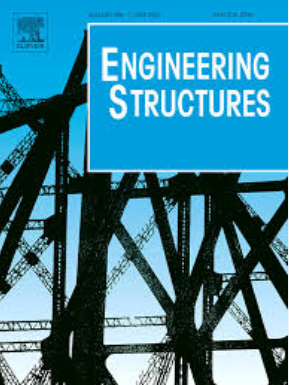时域子结构-土-结构相互作用分析中与频率无关的地基参数标定
IF 5.6
1区 工程技术
Q1 ENGINEERING, CIVIL
引用次数: 0
摘要
本文介绍了一种用于时域子结构-土-结构相互作用(SSI)分析的校准频率无关土-基础(CFISF)参数推导框架。虽然已经提出了各种频率相关阻抗函数的时域近似,以促进地震分析和设计中对SSI的考虑,但它们的实际实施往往面临一个关键的权衡:过度简化会损害精度,而过度复杂性会阻碍实际应用。为了解决这一限制,我们提出了一个框架来推导CFISF参数,该参数可以准确地模拟土壤-结构系统的时域响应,同时保持易于实现。该框架包括三个关键步骤。首先,通过量纲分析建立了CFISF参数与土-结构系统参数关系的函数形式。其次,利用贝叶斯模型反演技术对多种土壤-结构模型配置下的CFISF参数进行估计,得到综合的土壤-结构模型参数及其对应的CFISF参数估计数据集。该步骤包括:(1)使用直接方法模拟白噪声激励下的土-结构系统时域响应,该方法作为地面真值;(2)通过最小化直接模型与子结构模型响应之间的差异来估计CFISF参数。第三,对数据集进行回归分析,确定由量纲分析得出的函数形式的未知系数,得到CFISF参数的显式方程。为了评估CFISF参数在校准数据集之外的性能,我们对具有不同几何形状和材料特性的四种土壤结构系统进行了评估研究。结果表明,CFISF参数使子结构模型能够紧密地复制直接模型响应,优于传统的时域阻抗函数近似。该框架为实践界提供了将SSI效应纳入地震设计的可靠工具,提高了SSI建模和分析的准确性和效率。本文章由计算机程序翻译,如有差异,请以英文原文为准。
Calibrating frequency-independent soil–foundation parameters for time-domain substructure soil–structure interaction analysis
This study introduces a framework for deriving calibrated frequency-independent soil-foundation (CFISF) parameters for time-domain substructure soil-structure interaction (SSI) analysis. While various time-domain approximations of the frequency-dependent impedance function have been proposed to facilitate SSI consideration in seismic analysis and design, their practical implementation often faces a critical trade-off: oversimplification compromises accuracy, while excessive complexity hinders practical application. To resolve this limitation, we propose a framework to derive CFISF parameters that can accurately simulate the time-domain response of soil-structure systems while maintaining ease of implementation. The framework comprises three key steps. First, dimensional analysis establishes the functional forms of the relationships linking the CFISF parameters to the soil-structure system parameters. Second, a Bayesian model inversion technique is employed to estimate CFISF parameters for a broad range of soil-structure model configurations, generating a comprehensive dataset of soil-structure model parameters and their corresponding estimated CFISF parameters. This step involves: (1) simulating the time-domain soil-structure system response under white-noise excitation using the direct approach, which serves as the ground truth, and (2) estimating the CFISF parameters by minimizing discrepancies between the direct and substructure model responses. Third, regression analysis is applied to the dataset to determine the unknown coefficients of the functional forms derived from dimensional analysis, yielding explicit equations for the CFISF parameters. To evaluate the performance of CFISF parameters beyond the calibration dataset, we conducted an assessment study on four soil-structure systems with varying geometries and material properties. The results demonstrate that the CFISF parameters enable substructure models to closely replicate direct model responses, outperforming traditional time-domain impedance function approximations. This framework equips the practicing community with a reliable tool for incorporating SSI effects into seismic design, enhancing both the accuracy and efficiency of SSI modeling and analysis.
求助全文
通过发布文献求助,成功后即可免费获取论文全文。
去求助
来源期刊

Engineering Structures
工程技术-工程:土木
CiteScore
10.20
自引率
14.50%
发文量
1385
审稿时长
67 days
期刊介绍:
Engineering Structures provides a forum for a broad blend of scientific and technical papers to reflect the evolving needs of the structural engineering and structural mechanics communities. Particularly welcome are contributions dealing with applications of structural engineering and mechanics principles in all areas of technology. The journal aspires to a broad and integrated coverage of the effects of dynamic loadings and of the modelling techniques whereby the structural response to these loadings may be computed.
The scope of Engineering Structures encompasses, but is not restricted to, the following areas: infrastructure engineering; earthquake engineering; structure-fluid-soil interaction; wind engineering; fire engineering; blast engineering; structural reliability/stability; life assessment/integrity; structural health monitoring; multi-hazard engineering; structural dynamics; optimization; expert systems; experimental modelling; performance-based design; multiscale analysis; value engineering.
Topics of interest include: tall buildings; innovative structures; environmentally responsive structures; bridges; stadiums; commercial and public buildings; transmission towers; television and telecommunication masts; foldable structures; cooling towers; plates and shells; suspension structures; protective structures; smart structures; nuclear reactors; dams; pressure vessels; pipelines; tunnels.
Engineering Structures also publishes review articles, short communications and discussions, book reviews, and a diary on international events related to any aspect of structural engineering.
 求助内容:
求助内容: 应助结果提醒方式:
应助结果提醒方式:


